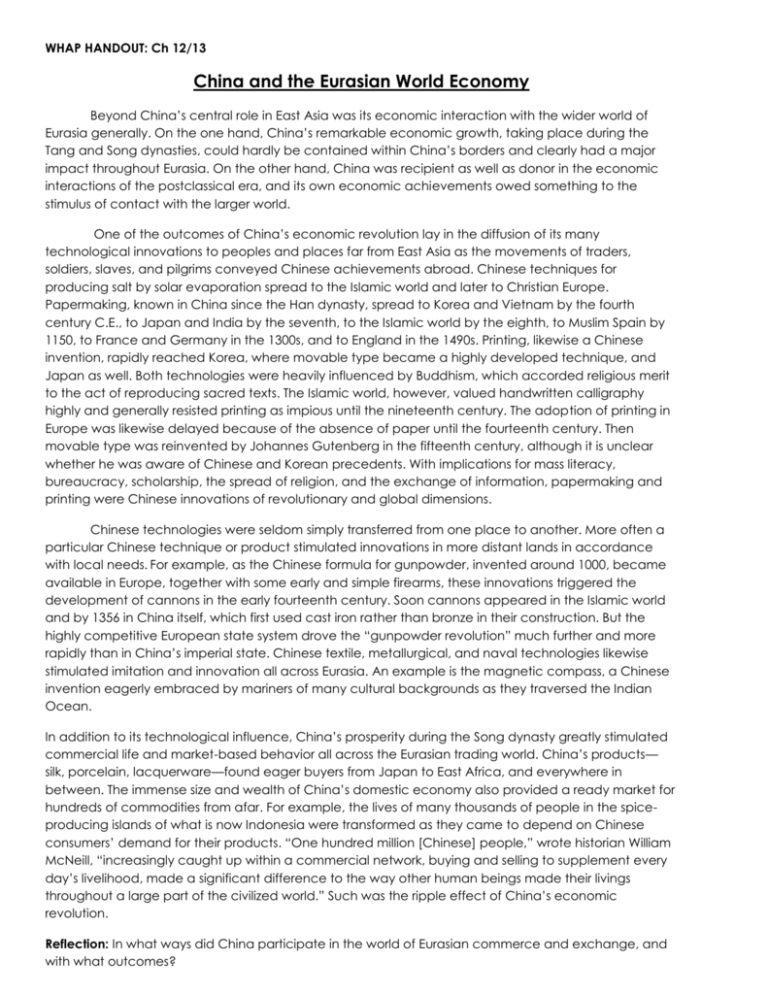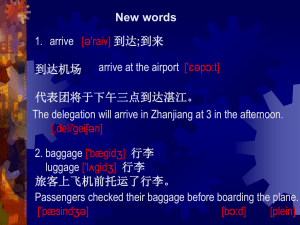China and the Eurasian World Economy
advertisement

WHAP HANDOUT: Ch 12/13 China and the Eurasian World Economy Beyond China’s central role in East Asia was its economic interaction with the wider world of Eurasia generally. On the one hand, China’s remarkable economic growth, taking place during the Tang and Song dynasties, could hardly be contained within China’s borders and clearly had a major impact throughout Eurasia. On the other hand, China was recipient as well as donor in the economic interactions of the postclassical era, and its own economic achievements owed something to the stimulus of contact with the larger world. One of the outcomes of China’s economic revolution lay in the diffusion of its many technological innovations to peoples and places far from East Asia as the movements of traders, soldiers, slaves, and pilgrims conveyed Chinese achievements abroad. Chinese techniques for producing salt by solar evaporation spread to the Islamic world and later to Christian Europe. Papermaking, known in China since the Han dynasty, spread to Korea and Vietnam by the fourth century C.E., to Japan and India by the seventh, to the Islamic world by the eighth, to Muslim Spain by 1150, to France and Germany in the 1300s, and to England in the 1490s. Printing, likewise a Chinese invention, rapidly reached Korea, where movable type became a highly developed technique, and Japan as well. Both technologies were heavily influenced by Buddhism, which accorded religious merit to the act of reproducing sacred texts. The Islamic world, however, valued handwritten calligraphy highly and generally resisted printing as impious until the nineteenth century. The adoption of printing in Europe was likewise delayed because of the absence of paper until the fourteenth century. Then movable type was reinvented by Johannes Gutenberg in the fifteenth century, although it is unclear whether he was aware of Chinese and Korean precedents. With implications for mass literacy, bureaucracy, scholarship, the spread of religion, and the exchange of information, papermaking and printing were Chinese innovations of revolutionary and global dimensions. Chinese technologies were seldom simply transferred from one place to another. More often a particular Chinese technique or product stimulated innovations in more distant lands in accordance with local needs. For example, as the Chinese formula for gunpowder, invented around 1000, became available in Europe, together with some early and simple firearms, these innovations triggered the development of cannons in the early fourteenth century. Soon cannons appeared in the Islamic world and by 1356 in China itself, which first used cast iron rather than bronze in their construction. But the highly competitive European state system drove the “gunpowder revolution” much further and more rapidly than in China’s imperial state. Chinese textile, metallurgical, and naval technologies likewise stimulated imitation and innovation all across Eurasia. An example is the magnetic compass, a Chinese invention eagerly embraced by mariners of many cultural backgrounds as they traversed the Indian Ocean. In addition to its technological influence, China’s prosperity during the Song dynasty greatly stimulated commercial life and market-based behavior all across the Eurasian trading world. China’s products— silk, porcelain, lacquerware—found eager buyers from Japan to East Africa, and everywhere in between. The immense size and wealth of China’s domestic economy also provided a ready market for hundreds of commodities from afar. For example, the lives of many thousands of people in the spiceproducing islands of what is now Indonesia were transformed as they came to depend on Chinese consumers’ demand for their products. “One hundred million [Chinese] people,” wrote historian William McNeill, “increasingly caught up within a commercial network, buying and selling to supplement every day’s livelihood, made a significant difference to the way other human beings made their livings throughout a large part of the civilized world.” Such was the ripple effect of China’s economic revolution. Reflection: In what ways did China participate in the world of Eurasian commerce and exchange, and with what outcomes?





